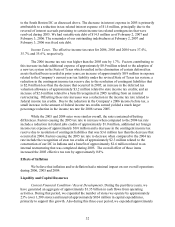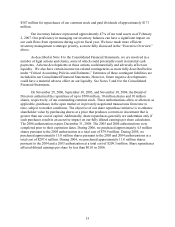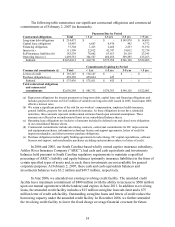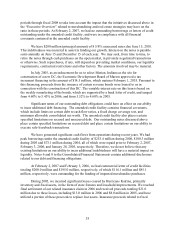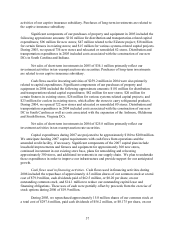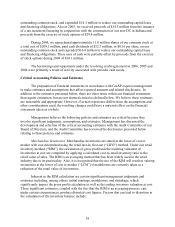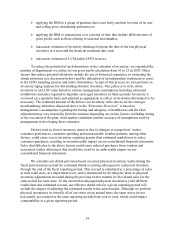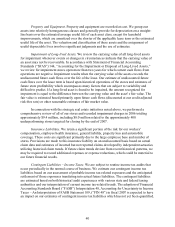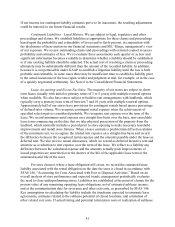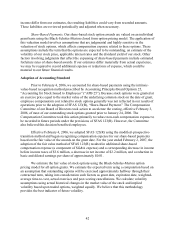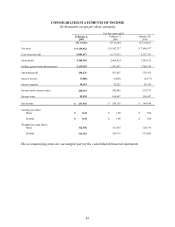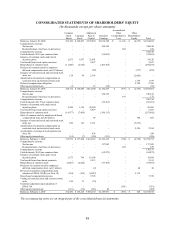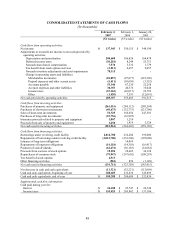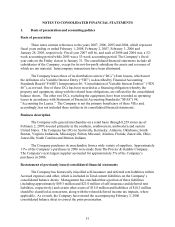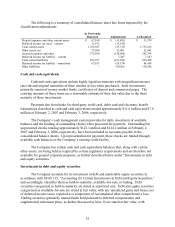Dollar General 2006 Annual Report Download - page 44
Download and view the complete annual report
Please find page 44 of the 2006 Dollar General annual report below. You can navigate through the pages in the report by either clicking on the pages listed below, or by using the keyword search tool below to find specific information within the annual report.income differ from our estimates, the resulting liabilities could vary from recorded amounts.
These liabilities are reviewed periodically and adjusted when necessary.
Share-Based Payments. Our share-based stock option awards are valued on an individual
grant basis using the Black-Scholes-Merton closed form option pricing model. The application of
this valuation model involves assumptions that are judgmental and highly sensitive in the
valuation of stock options, which affects compensation expense related to these options. These
assumptions include the term that the options are expected to be outstanding, an estimate of the
volatility of our stock price, applicable interest rates and the dividend yield of our stock. Other
factors involving judgments that affect the expensing of share-based payments include estimated
forfeiture rates of share-based awards. If our estimates differ materially from actual experience,
we may be required to record additional expense or reductions of expense, which could be
material to our future financial results.
Adoption of Accounting Standard
Prior to February 4, 2006, we accounted for share-based payments using the intrinsic-
value-based recognition method prescribed by Accounting Principles Board Opinion 25,
“Accounting for Stock Issued to Employees” (“APB 25”). Because stock options were granted at
an exercise price equal to the market value of the underlying common stock on the date of grant,
employee compensation cost related to stock options generally was not reflected in our results of
operations prior to the adoption of SFAS 123(R), “Share-Based Payment.” The Compensation
Committee of our Board of Directors took action to accelerate the vesting, effective February 3,
2006, of most of our outstanding stock options granted prior to January 24, 2006. The
Compensation Committee took this action primarily to reduce non-cash compensation expense to
be recorded in future periods under the provisions of SFAS 123(R). However, the Committee
also believed this decision benefited employees.
Effective February 4, 2006, we adopted SFAS 123(R) using the modified–prospective-
transition method and began recognizing compensation expense for our share-based payments
based on the fair value of the awards on the grant date. For the year ended February 2, 2007, the
adoption of the fair value method of SFAS 123(R) resulted in additional share-based
compensation expense (a component of SG&A expense) and a corresponding decrease in income
before income taxes of $3.6 million, a decrease in net income of $2.2 million, and a reduction in
basic and diluted earnings per share of approximately $0.01.
We estimate the fair value of stock options using the Black-Scholes-Merton option
pricing model for all option grants. We estimate the expected term using a computation based on
an assumption that outstanding options will be exercised approximately halfway through their
contractual term, taking into consideration such factors as grant date, expiration date, weighted-
average time-to-vest, actual exercises and post-vesting cancellations. We calculate volatility
assumptions using actual historical changes in the market value of the stock and implied
volatility based upon traded options, weighted equally. We believe that this methodology
provides the best indicator of future volatility.
42


